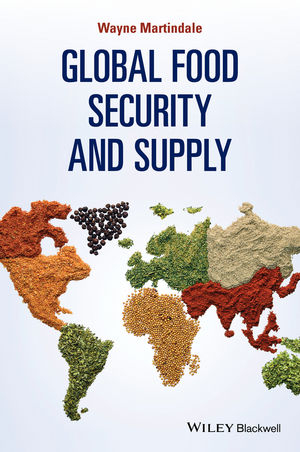
Global Food Security and Supply
Wiley-Blackwell (Verlag)
978-1-118-69932-4 (ISBN)
Global Food Security and Supply provides robust, succinct information for people who want to understand how the global food system works. The book demonstrates the specific tools available for understanding how food supply works, addresses the challenges facing a secure and safe global food supply, and helps readers to appreciate how these challenges might be overcome.
This book is a concise and accessible text that focuses on recent data and findings from a range of international collaborations and studies. The author provides both a snapshot of global food supply and security today, and a projection of where these issues may lead us in the future. This book will therefore be of particular interest to food policy leaders, commercial managers in the food industry, and researchers and students seeking a better understanding of a rapidly evolving topic.
Dr Wayne Martindale is a research fellow at Sheffield Business School, UK, looking at resource efficiency within the food industry. His research updates and blog can be found at www.waynemartindale.com
About the Author xiii
Preface xv
Introduction xix
1 The Basis for Food Security 1
1.1 Defining What Food Security Is and How Food Supply Chains Can Deliver It 1
1.2 The Convergence of Food Security Research, Economics, and Policy 6
1.3 The Millennium Development Goals (MDGs) 8
1.4 Measuring Hunger in a Changing World to Establish Security 11
1.5 The Undernutrition and Overnutrition Gap 13
1.6 The Supply Chain and Nutrition Gaps 15
1.7 The Relationship between Food Security and Biology 18
1.8 The Relationship between Food Security and Biotechnology 26
1.9 Genetic Diversity of Agricultural Crops and Livestock 28
1.10 Trade Agreements and the Development of Agricultural Supply 30
References 31
2 Understanding Food Supply Chains 39
2.1 Current Methods of Assessing Food Supply Chain Efficiencies That Enable Food Security Projections 39
2.2 How Population Growth and Limiting Factors Defi ne Demand and Food Security 40
2.3 Global Population Estimates and Projections 42
2.4 Consumption and Population Growth: Demonstrating the Impact of Dietary Changes and Transitions 44
2.5 Optimising Nutrition across Supply Chains Is the Focus of the Second Green Revolution 47
2.6 The Emergence of Sustainable Farming Reconnecting Supply Chains: A Case Study of the Establishment of the Landcare Movement in Australia 49
2.7 The Long-Term Field Experiments at Rothamsted and Their Power of Demonstrating Good Nutrient Balance in Agriculture Has Been Crucial to the Development of Sustainable Food Supply 50
2.8 Long-Term Field Experiments Hold Critical Data That Provide Our
Understanding of Nutrient Flows in Farming Systems So That Sustainable Food Supply Chains Are Developed 52
2.9 The Sustainable Production of Livestock and Long-Term Data 55
2.10 The Historical Proof of the Value of Agricultural Innovations in Providing Food Security 56
2.11 The Relationship between Field Trials, Investments, and Innovation 61
References 62
3 The Scientific Basis for Food Security 69
3.1 The Supply of Essential Plant Nutrients 69
3.2 Plant Nutrients and Phytonutrients in the Food Supply Chain: Establishing a Nutritional Understanding Using Human Trials 73
3.3 Biomass, the Base of the Supply Chain 77
3.4 The Interception of Light by Crop Canopies: How the Molecular Scale Impacts on Food Supply Chain Efficiency 79
3.5 The Requirement for Breeding New Crop Varieties and Selecting for Increased Sink Capacity of Crops 83
3.6 Photosynthetic Metabolism, the Biochemical Driver of Production 84
3.7 Environmental Stress Events and Their Impacts on Food Supply 86
3.8 The Principles of Integrated Management across the Food Chain: A Food Supply Chain Perspective 90
3.9 The Modern Agricultural System, the Dietary Interface, and Food Supply 91
References 93
4 The Sociological Basis for Food Security 97
4.1 Challenges and Solutions 97
4.2 Free Trade Transitions into Sustainability 101
4.3 Increasing Food Supplies Have Been a Major Achievement since 1975, but There Is Increased Resource Nationalism Evident by the Emergence of ‘National Interests in a Shrinking World’ 102
4.4 A Demonstration of Energy Balance and LCA for Sugar Production in Europe 110
4.5 Carbon Footprinting for Food Manufacturers Begins to Offer a Sustainability Reporting Framework 117
4.6 What Can We Do with Sustainability Assessments of Food Products? Using Carbon Footprint Data in Supply Chain Management 122
4.7 The Interactions between Affordability, Accessibility, and Food Security 124
4.8 Retail, Distribution, and Wholesale 131
4.9 Developing Diets for Improved Sustainability and Health Criteria 142
References 147
5 Challenges and Solutions 153
5.1 The Food System Challenge of This Century: Is a Sustainable Diet Now Defined? 153
5.2 Supply Chain Challenges: Integrating the LCA Approaches in Agriculture, Manufacturing, and Retail 159
5.3 Visualising the Data from the Food System Using GIS-LCA 164
5.4 Technology Enablers and Opportunities 167
References 172
6 The Future and Our Conclusion 177
6.1 The Future Food System 177
6.2 Our Conclusion 186
References 189
Index 191
| Erscheint lt. Verlag | 15.12.2014 |
|---|---|
| Verlagsort | Hoboken |
| Sprache | englisch |
| Maße | 152 x 230 mm |
| Gewicht | 381 g |
| Themenwelt | Technik ► Lebensmitteltechnologie |
| Weitere Fachgebiete ► Land- / Forstwirtschaft / Fischerei | |
| ISBN-10 | 1-118-69932-7 / 1118699327 |
| ISBN-13 | 978-1-118-69932-4 / 9781118699324 |
| Zustand | Neuware |
| Haben Sie eine Frage zum Produkt? |
aus dem Bereich


